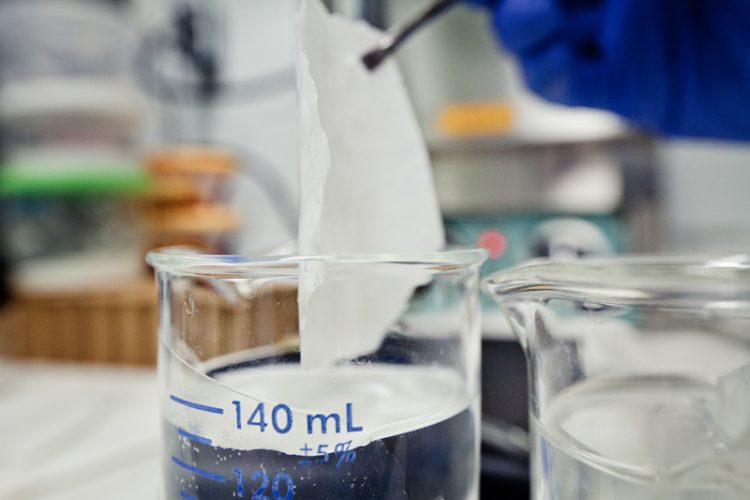User research at BESSY II: How new materials increase the efficiency of direct ethanol fuel cells

The material consists of Nafion with embedded nanoparticles. © B.Matos/IPEN
Ethanol has five times higher volumetric energy density (6.7 kWh/L) than hydrogen (1.3 kWh/L) and can be used safely in fuel cells for power generation. In Brazil in particular there is great interest in better fuel cells for ethanol as all the country distributes low-cost ethanol produced in a renewable way from sugar cane.
Theoretically, the efficiency of an ethanol fuel cell should be 96 percent, but in practice at the highest power density it is only 30 percent, due to a variety of reasons. So there is great room for improvements.
Nafion with nanoparticles
A team led by Dr. Bruno Matos from the Brazilian research institute IPEN is therefore investigating novel composite membranes for direct ethanol fuel cells. A promising solution is tailoring new polymer-based composite electrolyte materials to replace the state-of-the-art polymer electrolyte such as Nafion.
Matos and his team use melt extrusion process to produce composite membranes based on Nafion with additional titanate nanoparticles, which have been functionalized with sulfonic acid groups.
Infrared experiments at BESSY II
Matos' team has now thoroughly analysed four different compositions of Nafion composite membranes at the infrared beamline IRIS at BESSY II. Small-angle X-ray scattering measurements confirmed that the titanium particles were synergistically interacting with the ionomer matrix of Nafion.
Proton conductivity increased
Using infrared spectroscopy, they observed that chemical bridges were formed between the sulfonic acid groups of the functionalized nanoparticles. In addition, by following the proton motion along the ionic clusters, they found increased proton conductivity in the composite membrane, even at high concentrations of nanoparticles.
“This was a real surprise that we didn't expect,” Dr. Ljiljana Puskar, HZB-scientist at the IRIS-Beamline says. The reduction of the conductivity with the increment of the nanoparticles is one of the main hurdles delaying the development of high-performance composite materials. The higher proton conductivity could allow better charge carrier mobility and thus increase the efficiency of the direct ethanol fuel cell.
Advantage of melt extrusion
“This composite membrane can be produced by melt extrusion, which would allow their production on industrial scale,” Matos points out.
Dr. Ljiljana Puskar
E-Mail:
Dr. Bruno Ribeiro de Matos
E-Mail: brmatos@usp.br
DOI: 10.1016/j.memsci.2020.118042
https://www.helmholtz-berlin.de/pubbin/news_seite?nid=21288;sprache=en;seitenid=…
http://dx.doi.org/10.1016/j.memsci.2020.118042
Media Contact
All latest news from the category: Materials Sciences
Materials management deals with the research, development, manufacturing and processing of raw and industrial materials. Key aspects here are biological and medical issues, which play an increasingly important role in this field.
innovations-report offers in-depth articles related to the development and application of materials and the structure and properties of new materials.
Newest articles

High-energy-density aqueous battery based on halogen multi-electron transfer
Traditional non-aqueous lithium-ion batteries have a high energy density, but their safety is compromised due to the flammable organic electrolytes they utilize. Aqueous batteries use water as the solvent for…

First-ever combined heart pump and pig kidney transplant
…gives new hope to patient with terminal illness. Surgeons at NYU Langone Health performed the first-ever combined mechanical heart pump and gene-edited pig kidney transplant surgery in a 54-year-old woman…

Biophysics: Testing how well biomarkers work
LMU researchers have developed a method to determine how reliably target proteins can be labeled using super-resolution fluorescence microscopy. Modern microscopy techniques make it possible to examine the inner workings…





















